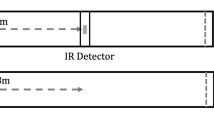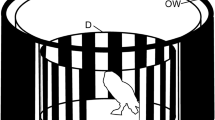Summary
-
1.
The way the sensitivity of the optokinetic response varies with azimuth and elevation was studied in several species of brachyuran crabs:Mictyris longicarpus andHeloecius cordiformis, both inhabiting mud flats;Carcinus maenas andPachygrapsus marmoratus, inhabiting densely structured environments.Mictyris is an exclusively forward walking crab, the other species usually run sideways.
-
2.
All species investigated respond maximally to lateral optokinetic stimulation. When they see with both eyes, variation of optokinetic sensitivity with azimuth is less pronounced than in monocular crabs.
-
3.
Species which live in flat environments only respond to optokinetic stimulation along and above the equator of the eye, species living in densely structured environments also respond to movement below the equator.
-
4.
In “flat world crabs”, the upper half of the eye views relatively distant objects. Moving their eyes only in response to motion above the horizon gives these crabs a way of avoiding the rotational component of the visual flow-field generated during locomotion. Thus the separation of the rotational from the translational component of the visual flow field is achieved without performing complicated computations but by taking advantage of the geometry of the situation.
Similar content being viewed by others
References
Buddenbrock W von, Friedrich H (1933) Neue Beobachtungen über die kompensatorischen Augenbewegungen und den Farbensinn der Taschenkrabben (Carcinus maenas). Z Vergl Physiol 19:747–761
Collett TS (1980) Some operating rules for the optomotor system of a hoverfly during voluntary flight. J Comp Physiol 138:271–282
Collett TS, Harkness LIK (1982) Depth vision in animals. In: Ingle DJ, Goodale MA, Mansfield RJW (eds) Analysis of visual behavior. MIT Press, Cambridge Mass, pp 111–176
Dahmen HJ (1980) A simple apparatus to investigate the orientation of walking insects. Experientia 36:685–687
Doom AJ van, Koenderink JJ (1982) Detectability of velocity gradients in moving random-dot patterns. Vision Res 23:799–804
Egelhaaf M (1985) On the neural basis of figure-ground discrimination by relative motion in the visual system of the fly. I. Behavioural constraints imposed on the neuronal network and the role of the optomotor system. Biol Cybern 52:123–140
Gibson JJ (1958) Visually controlled locomotion and visual orientation in animals. Br J Psychol 49:182–194
Horridge GA, Sandeman DC (1964) Nervous control of optokinetic responses in the crabCarcinus. Proc R Soc Lond B 161:216–246
Korte R (1966) Untersuchungen zum Sehvermögen einiger Decapoden insbesondere vonUca tangeri. Z Morphol Ökol Tiere 58:1–37
Kunze P (1963) Der Einfluß der Größe bewegter Felder auf den optokinetischen Augennystagmus der Winkerkrabbe (Uca pugnax). Ergeb Biol 26:55–62
Kunze P (1964) Eyestalk reactions of the ghost crabOcypode. In: Reiss RF (ed) Neural theory and modelling. Stanford University Press, Stanford, pp 293–304
Longuet-Higgins HC, Prazdny K (1980) The interpretation of a moving retinal image. Proc R Soc Lond B 208:385–397
Nakayama K (1983) Motion parallax sensitivity and space perception. In: Hein A, Jeannerod M (eds) Spatially oriented behavior. Springer, New York Berlin Heidelberg, pp 223–242
Nalbach H-O (1982) Reaktionen der KrabbeCarcinus maenas auf monokulare and binokulare optokinetische Reize. Diploma thesis, University of Tübingen
Nalbach H-O, Thier P, Varjú D (1985) Light-dependent eye coupling during the optokinetic response of the crabCarcinus maenas (L.). J Exp Biol 119:103–114
Rieger JH, Toet L (1985) Human visual navigation in the presence of 3-D rotations. Biol Cybern 52:377–381
Salmon M, Hyatt GW (1983) Communication. In: Vernberg FJ, Vernberg WG (eds) The biology of Crustacea, vol 7, Behavior and ecology. Academic Press, New York London, pp 1–10
Sandeman DC (1968) A sensitive position measuring device for biological systems. Comp Biochem Physiol 24:635–638
Sandeman DC (1978) Regionalization in the eye of the crabLeptograpsus variegatus: eye movements evoked by a target moving in different parts of the visual field. J Comp Physiol 123:299–306
Varjú D, Sandeman DC (1982) Eye movements of the crabLeptograpsus variegatus elicited by imposed leg reactions. J Exp Biol 98:151–173
Virsik R, Reichardt W (1976) Detection and tracking of moving objects by the flyMusca domestica. Biol Cybern 23:83–98
Wehner R (1981) Spatial vision in arthropods. In: Autrum H (ed) Vision in invertebrates (Handbook of sensory physiology, vol VII/6C). Springer, Berlin Heidelberg New York, pp 287–616
Zeil J, Nalbach G, Nalbach H-O (1986) Eyes, eye stalks and the visual world of semi-terrestrial crabs. J Comp Physiol A 159:801–811
Author information
Authors and Affiliations
Rights and permissions
About this article
Cite this article
Nalbach, HO., Nalbach, G. Distribution of optokinetic sensitivity over the eye of crabs: its relation to habitat and possible role in flow-field analysis. J. Comp. Physiol. 160, 127–135 (1987). https://doi.org/10.1007/BF00613448
Accepted:
Issue Date:
DOI: https://doi.org/10.1007/BF00613448




